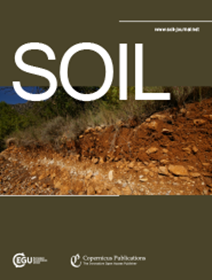The effect of groundwater depth on topsoil organic matter mineralization during a simulated dry summer in northwestern Europe
IF 4.3
2区 农林科学
Q1 SOIL SCIENCE
引用次数: 0
Abstract
Abstract. With climate change expected to intensify the occurrence and severity of droughts, the impacts of the groundwater table (GWT) depth and capillary rise on topsoil moisture may become critical drivers of biological activity. Consequently, the GWT depth could influence topsoil carbon (C) mineralization. In this study, undisturbed 200 cm long soil columns with three different textures (loamy sand, sandy loam and silt loam) were subjected to two artificial GWT depths (−165 and −115 cm) in the laboratory. We examined (1) upward moisture flow by capillary action along the soil profile, specifically into the top 20 cm of soil, and (2) the effect of the GWT on the decomposition of an added 13C-enriched substrate (ryegrass) over a period of 10 weeks, with limited wetting events representing a dry summer. A 50 cm difference in the GWT depth (−165 vs. −115 cm) resulted in different topsoil moisture values for the sandy loam (31 % vs. 38 % water-filled pore space – WFPS) and silt loam (33 % vs. 43 % WFPS) soils. In the loamy sand soil, GWT-induced moisture differences appeared only up to 85 cm above the GWT. The expected acceleration of the mineralization of the added ryegrass under a shallower GWT was not confirmed. In contrast, CO2 efflux pulses after some of the wetting events were even higher for the drier −165 cm GWT than for the −115 cm GWT across all three soil textures. Additionally, a model fitted to cumulative ryegrass mineralization showed a lower mineralization rate for the stable Cryegrass pool in the silt loam soil with the shallowest GWT, where capillary rise contributed most significantly to topsoil moisture, compared with other combinations of soil texture and GWT depth. These findings suggest that the upward capillary moisture flow, along with the resulting increase in topsoil moisture and the anticipated enhancement of biological activity and ryegrass mineralization, might have been counteracted by other processes. One possible explanation could be that rewetting may have triggered a stronger mineralization response, commonly known as the Birch effect, in drier topsoils compared with conditions in which the soil remained consistently wetter with a shallower GWT level. Based on our findings, inclusion of the process of texture-specific capillary supply from the GWT is required to adequately simulate moisture in the topsoil during droughts as they occurred over the past summers in northwestern Europe, depending on the GWT–texture combination. However, the net effect on topsoil C mineralization is complex and warrants further investigation, including the integration of processes related to fluctuations in soil moisture following rewetting.模拟欧洲西北部干旱夏季,地下水深度对表层土壤有机质矿化的影响
摘要。随着气候变化加剧干旱的发生和严重程度,地下水位(GWT)深度和毛细管上升对表土水分的影响可能成为生物活动的关键驱动因素。因此,GWT深度可能影响表层土壤碳(C)矿化。在本研究中,200厘米长的未受干扰的土柱具有三种不同的质地(壤土、砂质壤土和粉质壤土),在实验室中受到两个人工GWT深度(- 165和- 115厘米)的影响。我们研究了(1)毛细作用下沿土壤剖面向上流动的水分,特别是进入土壤顶部20厘米的水分流动;(2)在10周的时间里,GWT对增加的富含13c的基质(黑麦草)分解的影响,有限的润湿事件代表了一个干燥的夏天。50厘米的GWT深度差异(- 165和- 115厘米)导致了砂壤土(31%和38%充满水的孔隙空间- WFPS)和粉壤土(33%和43% WFPS)土壤的表土水分值不同。在壤土砂土中,GWT诱导的水分差异仅在GWT上方85 cm处出现。预期在较浅的GWT下添加黑麦草的矿化加速没有得到证实。相比之下,在所有三种土壤质地中,干燥的- 165 cm GWT在某些润湿事件后的CO2外排脉冲甚至高于- 115 cm GWT。此外,对累积黑麦草矿化的拟合模型显示,与其他土壤质地和GWT深度组合相比,GWT最浅的淤泥壤土中稳定黑麦草池的矿化率较低,其中毛管上升对表层土壤水分的贡献最大。这些发现表明,毛细管水分向上流动,以及由此导致的表土水分增加和预期的生物活性增强和黑麦草矿化可能被其他过程抵消。一种可能的解释是,在干燥的表层土壤中,再润湿可能引发了更强的矿化反应,即通常所说的白桦效应,而在较浅的GWT水平下,土壤一直保持湿润。基于我们的发现,根据GWT -纹理组合,需要包含GWT特定纹理毛细供应的过程,以充分模拟过去欧洲西北部夏季干旱期间表土中的水分。然而,对表层土壤C矿化的净影响是复杂的,需要进一步研究,包括与再润湿后土壤湿度波动相关的过程的整合。
本文章由计算机程序翻译,如有差异,请以英文原文为准。
求助全文
约1分钟内获得全文
求助全文
来源期刊

Soil
Agricultural and Biological Sciences-Soil Science
CiteScore
10.80
自引率
2.90%
发文量
44
审稿时长
30 weeks
期刊介绍:
SOIL is an international scientific journal dedicated to the publication and discussion of high-quality research in the field of soil system sciences.
SOIL is at the interface between the atmosphere, lithosphere, hydrosphere, and biosphere. SOIL publishes scientific research that contributes to understanding the soil system and its interaction with humans and the entire Earth system. The scope of the journal includes all topics that fall within the study of soil science as a discipline, with an emphasis on studies that integrate soil science with other sciences (hydrology, agronomy, socio-economics, health sciences, atmospheric sciences, etc.).
 求助内容:
求助内容: 应助结果提醒方式:
应助结果提醒方式:


